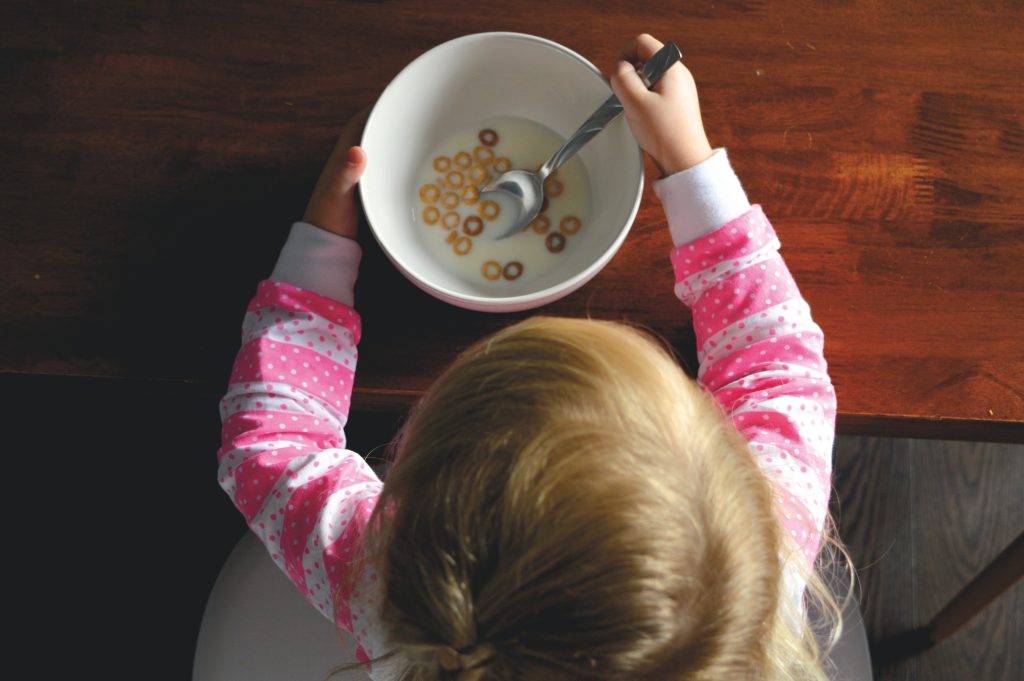Children develop their eating habits at a young age. In general, food preferences are shaped by early experiences with friends and family at home and school.
It’s common for parents to struggle with young children over eating a healthy, balanced diet.
One reason for this is that biologically, humans can differentiate between sweet and bitter from infancy, and our brains are hardwired to associate sugary sweetness with positive feelings and pain relief.
Fortunately, mealtimes don’t have to feel like an emotional power struggle. Instead of wrestling with kids to force healthy habits, here are four tried-and-true ways to adopt a more laid-back perspective on helping kids develop good eating habits.
1. Eat together

Eating together is helpful for several reasons.
First, it’s an excellent way to help your little ones establish a more consistent appetite and a routine for mealtimes. Even if they don’t eat much during the meal, they learn that this is the time when the whole family comes together to eat.
In that vein, young children like to copy the preferences and habits of people they like. If family members set a good example by eating a variety of foods and happily sitting down for a meal, chances are good that your little ones will follow along.
Because young children are so impressionable, it’s important to think about how you and your family members express opinions about food. It’s common to unintentionally establish or reinforce picky eating habits.
Even if you don’t like a particular food, you can frame it in a positive light, such as, “This isn’t my favourite food, but grandma loves it! You should see if you think it’s as yummy as grandma does.” This teaches them that it’s okay to have a preference, but it’s also good to try new things.
2. Prep and cook together

Kids love to learn and help. Whenever you can, try to let your child be the “sous chef” for a meal. This lets kids feel like they’re a part of the experience, and they are much more likely to want to eat the food they helped make.
This can start while you’re in the grocery store. You can let your children help pick out produce, and you can explain to them what the different kinds of meat are or why some foods are better for their bodies than others.
You can even incorporate other activities such as making a game out of putting away food. They can learn where fruits, veggies, healthy snacks and other groceries belong in the kitchen.
3. Give them a choice (and some autonomy)

It can be frustrating to deal with children who refuse to eat. Often, part of the problem stems from them feeling a lack of autonomy. They may not grasp why they can’t have ice cream for dinner, so they feel restricted and upset.
One way to deal with this is the “Division of Responsibility” technique. For meals, it’s the adult’s responsibility to determine what, where and when children eat. It’s the child’s responsibility to decide how much and if they eat what’s placed before them.
There will likely still be some less-than-harmonious mealtimes, but this is an exercise that can ultimately help both of you feel less stressed about eating. The child learns how much food to eat at mealtime to feel full and satisfied until the next meal or snack, and they also learn to accept that not all meals will be their favourite foods.
This technique is also helpful for parents who may feel anxious about “bad parenting” around eating. You are doing your responsibility by providing a variety of nutritious choices, and you are teaching your child that he or she has the freedom to choose whether or not to eat what you’re offering.
4. Let them have fun with their food

In this instance, it’s okay to play with your food. Try using fruits and veggies to create fun little games that make eating enjoyable.
For instance, you can give your kids Orchard Apple Rings and Sunshine Mango slices and teach them how to play tic-tac-toe with them. You can also make silly snack glasses to wear.
Dried fruits are a great, sweet alternative to candy or cookies, and they have lots of health benefits. For example, mango is rich in vitamin C, vitamin K and dietary fiber, which is good for healthy digestion. Dried apples are filling and packed with essential vitamins and minerals.
It’s even okay to make mealtimes into small games if it helps your child eat more. You can challenge little ones to “eat the rainbow” by seeing if they can eat at least one bite of food from every color in the rainbow.
Healthy doesn’t have to be hard
It’s normal for children to go through times where they eat more or less, depending on how their taste buds change and their bodies grow. These tips won’t prevent every mealtime meltdown, but they will help you and your little ones reframe healthy eating habits in a fun, low-stress way.





